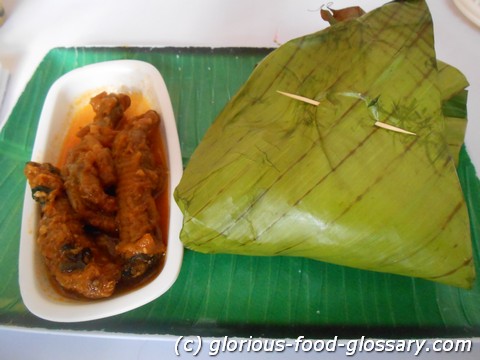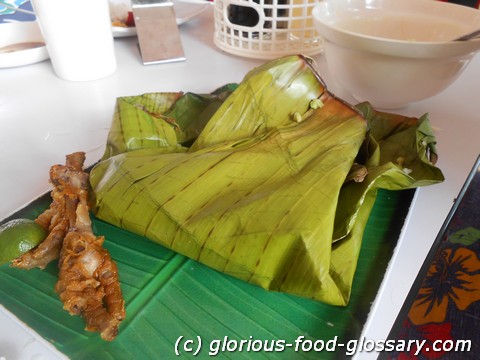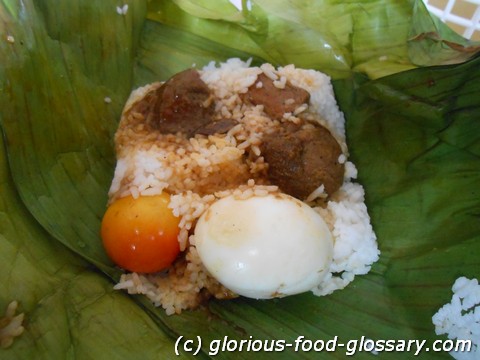English: Wrapped / Deutsch: Eingewickelt / Español: Envuelto / Português: Envolto / Français: Emballé / Italiano: Avvolto /
In the food context, "Binalot" is a traditional Filipino method of serving and packaging food where meals are wrapped in banana leaves. The word "binalot" literally translates to "wrapped" in English. This practice not only serves as an eco-friendly way to package food but also imparts a distinct aroma and flavor to the dish, enhancing the overall eating experience.
Culinary Uses:
Binalot is used for a variety of Filipino dishes, including but not limited to:
- Rice and Meat Combinations: A common binalot meal might consist of rice accompanied by a portion of meat, such as adobo (a popular Filipino dish made with chicken or pork marinated in vinegar, soy sauce, and garlic), grilled fish, or longganisa (Filipino sausage).
- Vegetable Dishes: Alongside rice and meat, vegetables like stir-fried water spinach (adobong kangkong) or pickled papaya (atchara) are also often included in the binalot.
- Festive and Everyday Occasions: Binalot is popular both for everyday meals and special occasions, offering a convenient and traditional way to enjoy Filipino cuisine.
Cultural Significance:
Binalot reflects the Filipino value of communal eating and sharing, as these wrapped meals are often enjoyed during family gatherings, fiestas, and picnics. The use of banana leaves as wrapping material is deeply ingrained in Filipino culture, symbolizing a connection to nature and a commitment to sustainability.
Environmental Aspect:
The binalot method aligns with sustainable practices by utilizing banana leaves, a biodegradable and renewable resource, as an alternative to plastic or other non-biodegradable packaging materials. This traditional method of food packaging showcases an early form of environmental consciousness in Filipino culinary practices.
Summary
Binalot is more than just a method of wrapping food; it is a cultural emblem that represents the Filipino way of life, emphasizing sustainability, community, and the importance of preserving traditional practices. It enhances the dining experience by adding a unique flavor to the food and serves as a reminder of the Philippines' rich culinary heritage.
--
Referred Picture:



Related Articles to the term 'Binalot' | |
| 'Moron' | ■■■■■■■■■ |
| Moron . . . . . . Read More | |
| 'Caldereta' | ■■■■■■■■ |
| Caldereta in the food context refers to a rich and flavorful Filipino stew made with tender meat, typically . . . Read More | |
| 'Rice Meal' | ■■■■■■■■ |
| A Rice Meal in the food context typically refers to a dish or a set of dishes where rice serves as the . . . Read More | |
| 'Filipino' | ■■■■■■■■ |
| Filipino in the food context refers to the culinary traditions and dishes originating from the Philippines, . . . Read More | |
| 'Maruya' | ■■■■■■■■ |
| Maruya is a traditional Filipino snack made from bananas, typically Saba bananas, which are battered . . . Read More | |
| 'Pinais na Isda' | ■■■■■■■■ |
| Pinais na Isda is a traditional Filipino dish that involves wrapping fish or shrimp in banana leaves . . . Read More | |
| 'Food and Drink/Cuisine of Chad Africa' | ■■■■■■■ |
| Food and Drink/Cuisine of Chad, Africa The cuisine of Chad varies according to region and ethnic group. . . . Read More | |
| 'Chagayu (Tea Gruel)' | ■■■■■■■ |
| Chagayu (Tea Gruel) refers to the Japanese popular food for Yamato people since ancient times. Chagayu . . . Read More | |
| 'Breakfast' | ■■■■■■■ |
| Breakfast is the first meal taken after rising from a night\'s sleep, most often eaten in the early morning . . . Read More | |
| 'Antojitos' | ■■■■■■■ |
| Antojitos is the Mexican word for \'appetizers\' and a term for \'street snacks\', popular of which are . . . Read More | |
